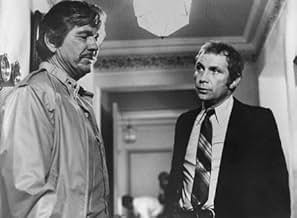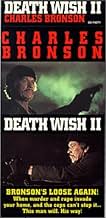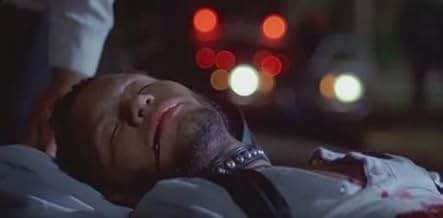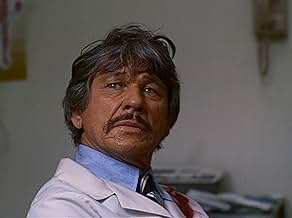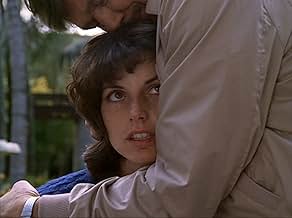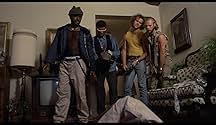AVALIAÇÃO DA IMDb
6,0/10
20 mil
SUA AVALIAÇÃO
O arquiteto Paul Kersey novamente se torna vigilante quando tenta encontrar os cinco punks de rua que assassinaram sua filha e governanta, desta vez nas ruas escuras de Los Angeles.O arquiteto Paul Kersey novamente se torna vigilante quando tenta encontrar os cinco punks de rua que assassinaram sua filha e governanta, desta vez nas ruas escuras de Los Angeles.O arquiteto Paul Kersey novamente se torna vigilante quando tenta encontrar os cinco punks de rua que assassinaram sua filha e governanta, desta vez nas ruas escuras de Los Angeles.
- Direção
- Roteiristas
- Artistas
- Prêmios
- 2 indicações no total
Thomas F. Duffy
- Nirvana
- (as Thomas Duffy)
Laurence Fishburne
- Cutter
- (as Laurence Fishburne III)
- Direção
- Roteiristas
- Elenco e equipe completos
- Produção, bilheteria e muito mais no IMDbPro
Avaliações em destaque
The second Death Wish film has a very strange concatenation of qualities. It can come dangerously close to running off the rails altogether, but overall, I think it's a more successful film than the first Death Wish.
The first peculiarity is that much more strongly than the first film, Death Wish II's urban crime-ridden backdrop is exaggerated to a point of caricature. Of course, there was plenty of crime in Los Angeles during this era, but not as depicted here. This is almost Broadway-style crime, with choreographed gaggles of hoodlums running out of control in designer gang-wear, making spectacles of themselves. It's over the top but serious in a way that feels uncomfortable at first, but then, that's just the point, and it helps anchor the plot developments that follow.
And that plot should be no surprise to anyone who first watches Death Wish I. Death Wish II follows the plot of its predecessor as if it were a fairly rigid template. Even the events that cause Paul Kersey (Charles Bronson) to take charge and clean up society's scum by his lonesome are very similar. I don't see this as a flaw here (as I don't in many other sequels that use a template approach, including series like Friday the 13th). This is a direct continuation of the story of the first film, and the similarity gives Death Wish II both a natural, logical flow and a nice symmetrical structure.
Although Death Wish I had its brutal moments, Death Wish II amplifies that atmosphere and sustains it through its length. Like the films that best display gritty 1970s New York City--such as Taxi Driver (1976) and Basket Case (1982)--Death Wish II makes you feel almost dirty (in the grimy despair way, not a sexual way) while watching it. It's ironic, maybe, that Death Wish II does this so well when the setting is Los Angeles as opposed to actually being New York City, as in the first film. That director Michael Winner is able to perpetuate that atmosphere, whether by accident or design, results in the viewer being sucked into the setting and vicariously experiencing the range of unpleasant emotions felt by both the protagonists and the antagonists.
Also helping on that end is the score, provided by Led Zeppelin guitarist Jimmy Page. Although Winner sometimes incorporates Page's music in a discordant, jarring way--over the opening credits when it fights for volume with radio banter, for example--more often than not the score gives Death Wish II a sublime, otherworldly and eerie edge. It's too bad that Page didn't go on to score many more films.
This is certainly not a film to show during family time, and it's not particularly uplifting or overflowing with positive messages or socially redeeming values. But it's not trying to be any of those things. It's just a visceral (especially on an emotional level), disturbing revenge flick, and at that, it meets its goals well.
The first peculiarity is that much more strongly than the first film, Death Wish II's urban crime-ridden backdrop is exaggerated to a point of caricature. Of course, there was plenty of crime in Los Angeles during this era, but not as depicted here. This is almost Broadway-style crime, with choreographed gaggles of hoodlums running out of control in designer gang-wear, making spectacles of themselves. It's over the top but serious in a way that feels uncomfortable at first, but then, that's just the point, and it helps anchor the plot developments that follow.
And that plot should be no surprise to anyone who first watches Death Wish I. Death Wish II follows the plot of its predecessor as if it were a fairly rigid template. Even the events that cause Paul Kersey (Charles Bronson) to take charge and clean up society's scum by his lonesome are very similar. I don't see this as a flaw here (as I don't in many other sequels that use a template approach, including series like Friday the 13th). This is a direct continuation of the story of the first film, and the similarity gives Death Wish II both a natural, logical flow and a nice symmetrical structure.
Although Death Wish I had its brutal moments, Death Wish II amplifies that atmosphere and sustains it through its length. Like the films that best display gritty 1970s New York City--such as Taxi Driver (1976) and Basket Case (1982)--Death Wish II makes you feel almost dirty (in the grimy despair way, not a sexual way) while watching it. It's ironic, maybe, that Death Wish II does this so well when the setting is Los Angeles as opposed to actually being New York City, as in the first film. That director Michael Winner is able to perpetuate that atmosphere, whether by accident or design, results in the viewer being sucked into the setting and vicariously experiencing the range of unpleasant emotions felt by both the protagonists and the antagonists.
Also helping on that end is the score, provided by Led Zeppelin guitarist Jimmy Page. Although Winner sometimes incorporates Page's music in a discordant, jarring way--over the opening credits when it fights for volume with radio banter, for example--more often than not the score gives Death Wish II a sublime, otherworldly and eerie edge. It's too bad that Page didn't go on to score many more films.
This is certainly not a film to show during family time, and it's not particularly uplifting or overflowing with positive messages or socially redeeming values. But it's not trying to be any of those things. It's just a visceral (especially on an emotional level), disturbing revenge flick, and at that, it meets its goals well.
Lady, you scream and disturb the neighbors, we'll cut you into little pieces and eat you for dinner!
Well, we don't get the great Herbie Hancock score of the first movie, but we do get Jill Ireland, Mrs. Bronson, in one of her last films, directed as Death Wish I and III, by Michael Winner.
We also get what I feel is the biggest collection of scumbags ever assembled. Thomas F. Duffy as Nirvana, Kevyn Major Howard as Stomper, Stuart K. Robinson as Jiver, Laurence Fishburne as Cutter, and E. Lamont Johnson as Punkut. It was fitting that the first kill occurred in a rat- infested building, and the last was an electrocution.
Vincent Gardenia is back to track down Kersey after he starts again in Los Angeles.
Unlike the serious and tragic first film, this is more focused and revenge-oriented. A good film, nonetheless.
We also get what I feel is the biggest collection of scumbags ever assembled. Thomas F. Duffy as Nirvana, Kevyn Major Howard as Stomper, Stuart K. Robinson as Jiver, Laurence Fishburne as Cutter, and E. Lamont Johnson as Punkut. It was fitting that the first kill occurred in a rat- infested building, and the last was an electrocution.
Vincent Gardenia is back to track down Kersey after he starts again in Los Angeles.
Unlike the serious and tragic first film, this is more focused and revenge-oriented. A good film, nonetheless.
Of all the Death Wish sequels, this was the best. I think once they got to up part 3 with all the machine guns and rocket launchers, then it started to get a little stupid. The story almost has an identical plot outline as the first one and the action is just as good, if not, then even better. The shootout at San Pedro park was awesome!!! The only difference is that they make Paul Kersey have more emotional interaction with the creeps he kills which makes it seem to be more "Hollywood". In the first Death Wish, Kersey would just kill them stone cold without having a conversation. That's why the original was so good as so realistic.
Architect Paul Kersey (Charles Bronson) once again becomes a vigilante when he tries to find the five street punks who murdered his daughter and housekeeper, this time on the dark streets of Los Angeles.
Early on, we have a nasty rape scene with Larry Fishburne. I mean really, really nasty. So much so that this film goes above and beyond the darkness from the first film.
That aside, I would say this is every bit as good as the original, and now with more of the 1980s feel (for good reason). We have Bronson kicking more butt, and even with more of a focus (and less moral ambiguity) than before... and Mr. Gardenia returns to really cap off the pure awesome of this series.
Early on, we have a nasty rape scene with Larry Fishburne. I mean really, really nasty. So much so that this film goes above and beyond the darkness from the first film.
That aside, I would say this is every bit as good as the original, and now with more of the 1980s feel (for good reason). We have Bronson kicking more butt, and even with more of a focus (and less moral ambiguity) than before... and Mr. Gardenia returns to really cap off the pure awesome of this series.
It's hard to believe that anyone who didn't like the first one wouldn't like this one. Bronson is back, this time avenging the death of his daughter and he's angrier than he's ever been. This one takes more of a action hero approach than the first one, but that's okay, you see, Bronson is a bad ass and that's all that matters. Movies like this aren't made to win best picture or best screenplay, they're made to be entertaining and filled with action, and that's what this is. Bronson has a great line he give to a punk just before he blows him away; he asks the punk if he believes in Jesus as the punk clutches a cross around his neck. The punk says "yes sir" so Bronson pauses and then tells him "you're going to meet him." Then he shoots him twice, it's great. Classic. I found no insight in this film, all I found was an awesome character who you can't get enough of that gets away with killing pieces of trash that rape, mug, and murder civilians. This formula is timeless, and the whole Death Wish series should be appreciated for proving so, because I'd watch one of these films before I watch any action film that may be produced today.
Você sabia?
- CuriosidadesAccording to Michael Winner's biography, Charles Bronson's alcoholic brother often visited the set to borrow money. Bronson was careful not to give him too much in case someone might kill him for it. He was later found dead in a cheap hotel room having been stabbed in the buttocks.
- Erros de gravaçãoKay tells Kersey he will wait three minutes before ringing the security alarm, yet he only waits about a minute or less.
- Citações
Paul Kersey: You believe in Jesus?
Stomper: Yes, I do.
Paul Kersey: Well, you're gonna meet him.
[Paul shoots Stomper dead]
- Versões alternativasThe R-rated US release is heavily edited missing part of the rape scene of the maid and most of the rape scene of Kersey's daughter (and her graphic suicide). The uncut version is available on BluRay.
- ConexõesFeatured in Not for Women Only: Episode dated 15 February 1982 (1982)
- Trilhas sonorasGo, Tell It on the Mountain
Traditional
Performed by the church congregation
Principais escolhas
Faça login para avaliar e ver a lista de recomendações personalizadas
Detalhes
- Data de lançamento
- País de origem
- Idiomas
- Também conhecido como
- El vengador anónimo II
- Locações de filme
- 1716 North Western Avenue, Los Angeles, Califórnia, EUA(Pioneer Chicken where Paul Kersey stares at the punks)
- Empresas de produção
- Consulte mais créditos da empresa na IMDbPro
Bilheteria
- Orçamento
- US$ 2.000.000 (estimativa)
- Faturamento bruto nos EUA e Canadá
- US$ 16.100.000
- Faturamento bruto mundial
- US$ 16.100.000
Contribua para esta página
Sugerir uma alteração ou adicionar conteúdo ausente





